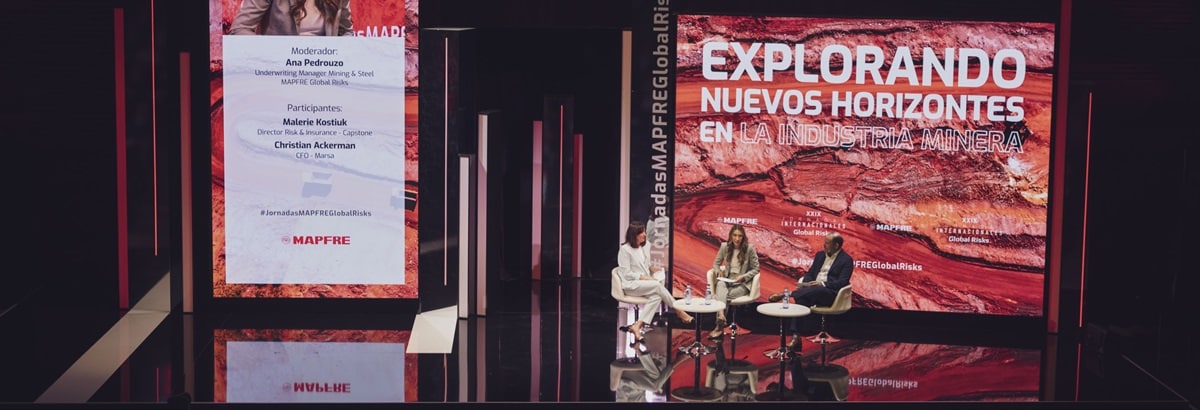Cristina Leon Vera | 31/10/2024
Mining has become a fundamental pillar of modern society, providing materials essential for technology, construction, and energy. In a world with ambitious sustainability objectives, the sector faces unprecedented challenges.
To address this situation, Ana Pedrouzo, expert in Underwriting in the areas of Property Damage, Mining, and Steelmaking at MAPFRE Global Risks, moderated an interesting discussion on the situation and potential of the mining industry during the International Seminar held by the company. Sitting next to her were Malerie Kostiuk, Risk and Insurance Manager at Capstone Cooper, and Christian Ackermann, CFO of Marsa.
Sustainable waste management
From cell phones, with more than 70 different materials, to renewable energy systems, these technologies need components extracted from mining. This connection with the industry is not exclusive to modern technology: for centuries, the sector has been key to areas such as construction, agriculture, and medicine. However, it is experiencing a milestone in its evolution, as the demand for minerals and metals is higher than ever. To make it sustainable and affordable, it has been essential to increase production in parallel with decarbonization and the mitigation of its environmental impact.
“One of the most significant changes we have seen in recent years is the way waste generated from mineral processing is managed,” explains Ana Pedrouzo, who highlighted the evolution from traditional waste dumps to tailings dewatering methods for dry storage. These systems reduce environmental and safety risks, but they also require greater investment from professionals in the sector. “It costs more money to implement this technology and increases operating costs, but at Capstone Cooper, we knew that the future of mining would take us along this path sooner or later. Why not invest in it in advance?” Kostiuk adds.
Another practice being implemented by her company is paste filling, which involves combining some of the waste with cement to fill the voids in the subsurface created by mining activities. “This practice also reinforces the safety of workers,” she says. Waste management is essential because, without a tailings storage system, the extraction and processing of minerals cannot begin, along with the bureaucratic complexity involved in launching a project of this magnitude. Environmental regulations are increasingly strict in this regard, and their noncompliance could lead to considerable fines to the loss of license to operate. “Tailings dams are certainly critical for any mining process, which is why we have strict limitations and constant monitoring for them.” Ackermann admitted.
Long-term implementation
One of the lesser-known aspects of mining is that, despite its prevalence and high demand, launching a project involves a significant amount of time and a large investment. Or as Christian Ackermann put it succinctly, “to deploy a gold mine, you need a gold mine.” The requirements vary from country to country, but generally, we are talking about years of waiting and multiple steps in the process, with requirements that can temporarily interrupt or even terminate planning. “We have several projects in Peru, with significant capital behind them, that have been underway for 15 to 20 years and still do not operate because obtaining approvals is difficult,” explained the CFO of Mars. At his company, they have invested in high technology as a pillar for development and cost savings, utilizing innovation in automation processes and hyper-convergence of IT systems.
Kostiuk added other initiatives that are making progress in mining, such as the sensorization of human assets and the identification of quality minerals for prioritization in processing. “Innovation in mining does not usually make the headlines, because it does not directly produce new products for mass consumption,” said Pedrouzo, “but it does allow safer and more productive operations. Mining and progress are linked and, now more than ever, the supply of sufficient and affordable materials will be key to sustainability and economic growth.”
What does the insurance industry contribute?
The complexity of the challenges faced by the sector sees the insurance industry as a guarantor of the future, particularly in products that adapt to its specificities. The reconstruction of mines, property damage, or activity interruptions can find in these tailored solutions a pathway to economic viability that meets the demands of this challenging context, which includes the difficulty of validating unavoidable aspects such as waste management in any of the types mentioned in this article. “The development of parametric solutions will be really important for our industry,” emphasizes Malerie Kostiuk, a sentiment echoed by Christian Ackermann, who also stresses the need to work hand in hand with brokers to improve business continuity plans while meeting ESG (Environmental, Social, and Governance) objectives. “The mining insurance market is highly specialized, and large experts in risk management and data analysis operate there. I believe that our companies must accompany them on this path toward innovation,” he concluded.





